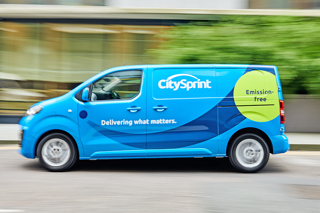Webfleet Solutions is eyeing growth in the company car market, driven by a desire to improve the health and wellbeing of all drivers.
Currently, more than half (55%) of its business comes from heavy goods vehicles (HGVs) and 35% from the light commercial vehicle (LCV) sector. Just 10% of its UK customer base is derived from the company car market, but Beverley Wise, sales and marketing director for Webfleet Solutions in the UK and Ireland, believes the time is right for growth.
Driver wellbeing is moving up the fleet agenda and Wise wants the business to play its part.
She explains: “A key focus for us this year is around how we can improve the welfare and health of your employees, because there’s an awful lot said about mental health and wellbeing in the workplace, but that’s defined by a building. All of the people we supply solutions to also have a workplace, it’s just a mobile workplace and the stress that comes with driving can be significant.”
Wise says stress can be detrimental to driving style, but by using telematics data to identify those underperforming drivers, you can then work with them to improve their wellbeing.
The technology, she says, is now widely accepted among truck and van drivers, who recognise its value to business and their personal health. But, she argues, business car drivers are “equally valuable” and ‘spy-in-the-cab’ fears should not outweigh the advantages that telematics can offer.
Wise believes how company car drivers interact with the technology can be crucial to overcoming some of those fears. For example, Webfleet Solutions gives drivers access to their data via an app, which Wise says offers transparency and gives employees a sense of control.
Furthermore, it can allow drivers to switch the app between business and private use, ensuring only business miles are tracked.
“It isn’t about trying to catch people out,” explains Wise. “This is about enhancing their daily lives, getting them home safely at night and reducing their stress.”
WEBFLEET PLATFORM
Webfleet Solutions delivers products through its Webfleet platform, which allows fleets to tailor a telematics package according to their needs thanks to its modular approach.
Connectivity is provided through plug-and-play hardware options via the vehicle’s on-board diagnostic (OBD) port, or there are fixed box options that offer greater functionality. Both offer data accessible through the company’s apps.
However, the range of functionality offered to a fleet is always guided by what they want to achieve, says Wise.
“I don’t want to sell somebody a box that goes into their vehicle,” she explains. “We try to understand the prospect’s pain points and what are their business objectives.”
Products available through the Webfleet platform include fleet management, fleet optimisation, asset tracking, driver behaviour monitoring and mileage, fuel and CO2 reporting.
It also operates an open application programming interface (API), which allows third-party partners to develop further products to benefit customers.
“If you’re an owner-operator or have a fleet of 30,000 vehicles, we believe we have a solution that will suit your requirements,” says Wise.
Furthermore, fleets can try out the technology for free for up to three months in 10 vehicles, allowing the decision-makers to assess the potential return on investment.
NEW OWNERS AND NAME
Webfleet Solutions has more than 50,000 customers operating across the globe, with Wise responsible for the business’s UK and Ireland division.
She was appointed sales and marketing director in 2016, with more than 20 years’ experience in the fleet industry.
She joined from Lex Autolease, where she was corporate sales director, having also previously held management roles with LeasePlan UK, BCA and incident management specialist FMG.
The past year, however, has seen significant change for her current employer, with a new name for the business and new owners.
Bridgestone announced the acquisition of TomTom Telematics for €910 million (£800m) in January 2019. The company name was changed to Webfleet Solutions last October.
Wise says the tyre manufacturer’s acquisition is “exciting” for the business, because of its move towards ‘mobility maintenance as a service’.
“They saw the benefits of working with us, especially as we are able to provide a lot of data,” she says.
The data access will enhance Bridgestone’s virtual tyre development and testing as well as connected tyre innovation. It also allows it to cross-sell tyres and solutions to Webfleet Solutions’ customer base.
It has already launched a range of digital solutions and applications such as Tirematics, Mobox, FleetPulse and Bridgestone Connect, having built capabilities in data collection from sensors, data platforms and analytics.
It believes it has the “perfect assets” to “accelerate” the Webfleet Solutions business. CEO and president of Bridgestone EMEA, Paolo Ferrari, explains: “When we acquired Webfleet Solutions, we created a fleet solutions powerhouse.
“Together we have every capability to lead in what is an incredibly exciting, fast growing and innovative area of mobility.
“We have the ambition, the infrastructure and resources, the data and insights, and we have the people and their unrivalled knowledge.
“As the new worlds of connected and autonomous mobility rapidly become a reality, together Bridgestone and Webfleet Solutions will ensure customers can enjoy every benefit of this new era.”
Bridgestone made its first appearance at the annual Consumer Electronics Show (CES) in Las Vegas in January. The Webfleet Solutions platform took centre stage on the company’s stand.
Wise says: “The transition from TomTom Telematics to Webfleet Solutions paves the way to a more connected, more holistic future in fleet and mobility management services.”
INCREASED CONNECTIVITY
But as vehicle connectivity increases, and more manufacturers offer factory-fitted telematics options, is this seen as a threat to the business?
Wise says multiple reports from different manufacturers, with operators running mixed fleets, would just lead to increased admin costs.
Furthermore, she says the packages available can be restricted, in terms of the data they provide and the algorithms they are based on.
“Are you comparing like-for-like? Possibly not,” she argues. “We still feel there is a benefit to having a single solution across your fleet to provide a single view of what your fleet is doing.”
Wise does acknowledge, however, that there will come a time when vehicle manufacturers open-up their data to third-party providers.
This data exchange, between a manufacturer and Webfleet Solutions, is already being delivered through its OEM Connect programme with PSA Group.
“If you run a PSA fleet, we can literally flick a switch and that data from that vehicle will appear on our platform,” says Wise.
PRODUCT DEVELOPMENT
As a standalone business, Webfleet Solutions has an in-house development team, which has delivered a range of new products in the past year, including a new mileage logbook app, as well as routing and scheduling and asset tracking solutions.
However, it will now also benefit from being part of Bridgestone, with access to its IT infrastructure and research and development.
The platform is continually improved and updated, says Wise, with the company taking a collaborative approach with users, allowing them to feedback to the development team.
“We are absolutely about delivering a solution that aids and enhances your business and your business objectives,” says Wise. “My mantra is to make customers look good in front of their peers.”






















Login to comment
Comments
No comments have been made yet.